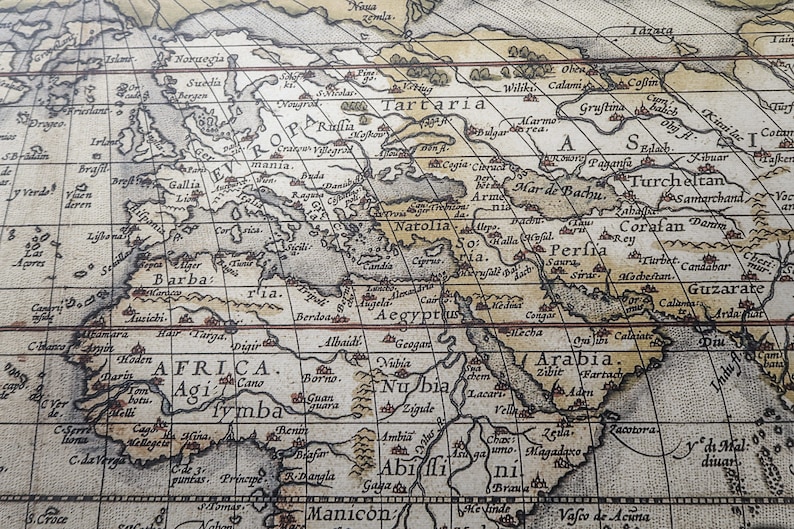

Nova Francia is shown, although the map debuted well before the visits of Champlain and the Jesuits. Lawrence reaching to the middle of the continent and a similar river running from the Gulf of Mexico to the same vicinity. North America is a study in guesswork and mythical cartography, including a projection of the St. The early mis-projection of Japan is prominent, as is the equally conjectural depiction of New Guinea and the Solomon Islands. The map includes a massive Terra Australis Nondum Cognita, a distinctive Northwest Passage below the Terra Septemtrionalis Incognita, and other early cartographic hypotheses. Abraham Ortelius (1527-1598) included the work as the first map in his atlas and it went through three editions in the later sixteenth century. One of the most famous world maps ever made, "Typus Orbis Terrarum" featured in the world's first atlas, Theatrum Orbis Terrarum. Latin Note in the Margins, including a reference to Amerigo Vespucci, the mythical Fortunate Islands and the Antarctic Region African Islands, including Madagascar (66).

After 1633, Hondius the Elder’s son-in-law, Johannes Janssonius, was also listed as a co-publisher for the atlas. Hondius died in 1612, at only 48 years of age, after which time his son of the same name and another son, Henricus, took over the business, including the reissuing of the Mercator atlas. When he acquired the Mercator plates, he added 36 maps, many engraved by him, and released the atlas under Mercator’s name, helping to solidify Mercator’s reputation posthumously. One of Hondius’ most successful commercial ventures was the reprinting of Mercator’s atlas. For example, from 1605 to 1610, Hondius engraved the plates for John Speed’s Theatre of the Empire of Great Britaine. Hondius worked in partnership with Cornelis Claesz, a publisher, and maintained his ties to contacts in Europe and England. In 1593 Hondius returned to Amsterdam, where he lived for the rest of his life. This network gave Hondius access to manuscript charts and descriptions which he then translated into engraved maps. His engraving and nautical painting skills introduced him to an elite group of geographic knowledge seekers and producers, including the navigators Drake, Thomas Cavendish, and Walter Raleigh, as well as engravers like Theodor De Bry and Augustine Ryther. Hondius also engraved the globe gores for Emery Molyneux’s pair of globes in 1592 Wright plotted the coastlines. There, he worked for Richard Hakluyt and Edward Wright, among others. Hondius moved to London in 1584, fleeing religious persecution in Flanders. Born in Wakken but raised in Ghent, the young Jodocus worked as an engraver, instrument maker, and globe maker. His work did much to establish Amsterdam as the center of cartographic publishing in the seventeenth century. Jodocus Hondius the Elder (1563-1612), or Joost de Hondt, was one of the most prominent geographers and engravers of his time.


 0 kommentar(er)
0 kommentar(er)
